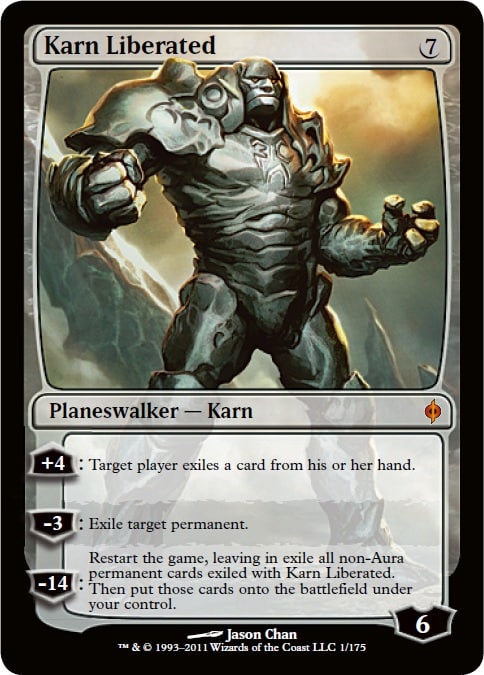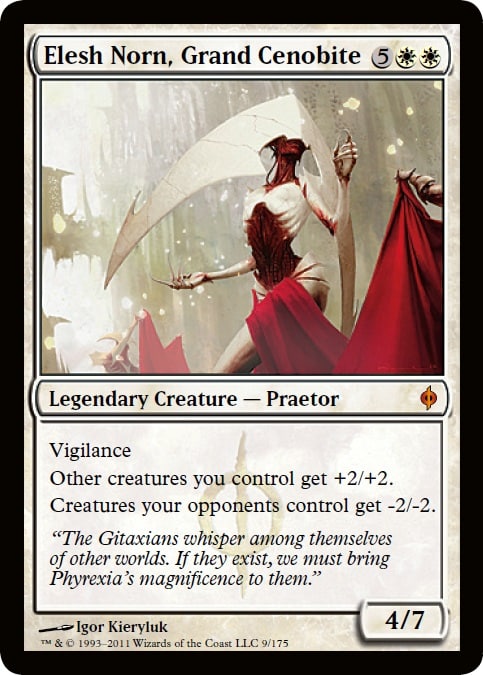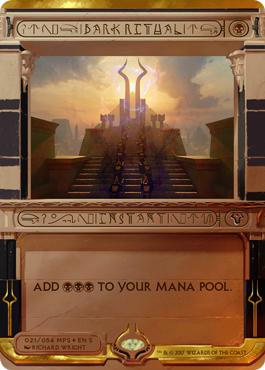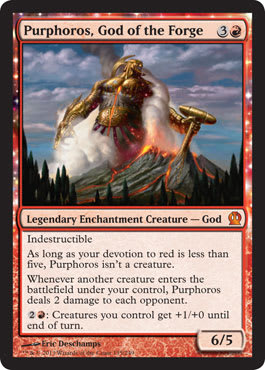When I started doing weekly cubing at my local game store, I started encountering a real first-world Cube problem: More people were showing up to Cube Drafts than my four-hundred-fifty-card Cube could handle.
To fix this, I came up with the concept of an expansion pack for my Cube. I've been utilizing an expansion pack in my cube for well over a year and I've found it useful in numerous ways. An expansion pack is a ninety-card supplemental addition to my Cube that fits into a hundred-count box that fits into my CubeVault so that I can make sure that when two more people draft my Cube, I'm prepared.
In this article, I'll talk about how to make use of expansion packs as tools to not just accommodate for more people, but to overall enrich your Cube's experience.
Since an expansion pack is going to mirror your Cube's composition, it's good to keep its ratios in check with what is currently in your Cube. One thing to note is that I sleeved basic lands in anticipation of using my Cube's expansion pack rather than have basic lands that go with the expansion pack. This makes it so that I've never run out of sleeved basics when drafting with my Cube without my expansion pack or with.
For reference, my Cube's current foundations are as follows:
- 61 W, U, B, R, and G (305 total)
- 30 multicolored
- 40 guild lands
- 74 colorless (including Karn Liberated, Simic Signet, Mishra's Factory, and Wurmcoil Engine)
- 7 miscellaneous/tri-hybrid (including Tasigur, the Golden Fang)
- 9 hybrid
- (90 colorless/miscellaneous/hybrid)
If you're wondering why I have two- and three-color hybrids as separate, I wrote a post about it on my blog a few months ago that explains why.
To keep that ratio, my ninety-card Cube expansion pack is as follows:
- 11 W, U, B, R, and G (55)
- 10 multicolored
- 10 guild lands
- 15 colorless (Since colorless cards, strictly percentage-wise, would be seventeen cards, rounding it down to fifteen allows for retaining a close ratio.)
Cube Expansion Pack W, U, and B ? Cube | Usman Jamil
- White (11)
- 1 Champion of the Parish
- 1 Eight-and-a-Half-Tails
- 1 Imposing Sovereign
- 1 Seeker of the Way
- 1 Valorous Stance
- 1 Honor of the Pure
- 1 Ajani, Caller of the Pride
- 1 Flickerwisp
- 1 Ojutai Exemplars
- 1 Archangel of Thune
- 1 Angel of Serenity
In my most recent Cube update, I experimented with taking out Vampire Lacerator and Sarcomancy, placing them here. If it weren’t for that experiment, I'd have cards like Carrion Feeder and Guul Draz Assassin here.
Cube Expansion Pack R, G, Multicolored, and Guild Lands ? Cube | Usman Jamil
- Red (11)
- 1 Reckless Waif
- 1 Scorched Rusalka
- 1 Smash to Smithereens
- 1 Gore-House Chainwalker
- 1 Borderland Marauder
- 1 Goblin Bombardment
- 1 Chandra's Phoenix
- 1 Prophetic Flamespeaker
- 1 Feldon of the Third Path
- 1 Flame Javelin
- 1 Rolling Earthquake
- Green (11)
- 1 Utopia Sprawl
- 1 Wall of Roots
- 1 Fertile Ground
- 1 Wild Mongrel
- 1 Devoted Druid
- 1 Rattleclaw Mystic
- 1 Vengevine
- 1 Freyalise, Llanowar's Fury
- 1 Kalonian Hydra
- 1 Foe-Razer Regent
- 1 Avenger of Zendikar
- Multicolored (10)
- 1 Supreme Verdict
- 1 Mirari's Wake
- 1 Tezzeret, Agent of Bolas
- 1 Xenagos, the Reveler
- 1 Kolaghan, the Storm's Fury
- 1 Sorin, Solemn Visitor
- 1 Lightning Helix
- 1 Lotleth Troll
- 1 Shardless Agent
- 1 Electrolyze
- Guild Lands (10)
- 1 Kessig Wolf Run
- 1 Horizon Canopy
- 1 Temple of Deceit
- 1 Temple of Enlightenment
- 1 Temple of Malice
- 1 Slayers' Stronghold
- 1 Cascade Bluffs
- 1 Llanowar Wastes
- 1 Fetid Heath
- 1 Yavimaya Coast
I don't run pure cycles of lands, instead having a number of lands for each two-color pair and using the best lands for their archetypes. Lands like Fetid Heath help the intensive black and white double-costs in the colors, whereas Kessig Wolf Run works well in R/G ramp decks while also giving value to early beaters mana Elves in the late game.
Cube Expansion Pack Colorless ? Cube | Usman Jamil
Best Practices
In previous articles and podcasts, I've talked about the use of an on-deck binder and how having an area where cards that aren't in your Cube—but are used as a bank of ideas to revisit—is a useful tool for your Cube to make sure that you're keeping all options available for your Cube, not just newly printed cards. That said, an expansion pack isn't just a best-of on-deck binder either.
For example, let's say that your on-deck binder has ten big, blue finishers such as Keiga, the Tide Star and Sphinx of Jwar Isle—both solid blue finishers. However, a Cube doesn't need to have that high number of finishers, and a ninety-card expansion pack with ten to twelve blue cards should only really have about one or two per color to support a blue section. This helps to retain the ratio of cards to make sure that you're not flooding a Cube with control finishers at the expense of aggressive cards since control decks don't necessarily need a critical mass of finishers to make their decks hum, whereas aggressive decks need a lot more small creatures and overall support.
This same ideology works with other types of effects like mass removal. A good way to think of an expansion pack is a way to bridge the gap between Cube sizes by maintaining consistency between the two sizes. If you look at the color sections in my expansion pack, the eleven adds were chosen to retain consistency by staying consistent to the overall mana curve and keeping archetype support consistent. For aggressive decks, as I mentioned in my Dragons of Tarkir review, I haven't cut any 1-mana, 2-power creatures in white because the aggressive decks haven't gotten to the point at which cutting those is correct, and because of that, I can't include any Savannah Lions–types of cards in the expansion pack, but I included cards like other 1-drop aggressive creatures, such as Champion of the Parish, and other 2-mana creatures, such as Imposing Sovereign, to support it the aggressive decks while giving control decks a few top-end cards, such as Angel of Serenity and Archangel of Thune. Like a Cube, it's a fluid expansion of the themes and archetypes that my Cube represent, and because of that, it's not set in stone.
All of these are cards that I wouldn't be embarrassed to see in my main Cube list and could easily make their ways back into my main list, but some, like Angel of Serenity, may have a hard time cracking back in due to constraints on high-mana-finisher effects, and there's only room for a small number of them (and when it comes down to it, Elesh Norn, Grand Cenobite offers more than Angel of Serenity.)
As an expansion pack can help to bridge the gaps between smaller sizes, it can help you to take advantage of the pros and cons of different Cube sizes—as long as you don't mind the shuffle times for shuffling the base Cube with the expansion pack. This allows you to have a "core" that you can keep to expand to if need be, whereas you can't really do the same in reverse. This can also be used to “bridge gaps” if a Cube has an odd number of cards. For example, if a Cube has four hundred cards, an expansion pack with fifty cards can be used to accommodate for a tenth drafter or to replicate some of the “mystery” from not having all of the cards drafted—if that type of effect is wanted.
Now that we've talked about how to create an expansion pack, how can an expansion pack improve your Cube experience?
The most obvious is that it allows you to have more people in your Draft so that if more than the usual come to the Draft, you don't have to turn people away. However, there's more to a Cube expansion pack than that.
In my first Quiet Speculation Cube article, I talked about how to build a Cube from its initial foundations, as its design constraints define a Cube, one of which is size.
Aside from dictating how many people can draft, there are strengths and weaknesses that come with small and large Cubes. Tolarian Community College's recent basic Cube-construction video talked briefly about it, but there hasn't really been an in-depth discussion of why one would go for a particular Cube size. For this article, I'll use these as rough size dimensions:
- Small: 360
- Med: ~450–630
- Large: ~630–720+
Pros of smaller lists:
- Individual cards are easier to build around and can have a bigger impact on the Draft itself (fetch lands plus dual lands, Stoneforge Mystic plus Equipment, and decks reliant on a few cards, such as Storm).
- Because it's more likely to see a card in the pod, it's also easier to track card performance of individual cards without needing to seed cards into the Draft pool.
- Average card quality grows higher as a Cube shrinks smaller due to competition.
Cons:
- When maintaining a Cube, making cuts can be harder in smaller lists. I have a three-hundred-sixty-card Pauper Cube, and I've found that cuts are harder since going from four hundred fifty cards to three hundred sixty cards.
- A small Cube, especially if drafted often, can lead to a “samey” feel—you're seeing the same individual cards more often than if the Cube were larger.
- Since average Cube card quality is higher, some cards may have a harder time of making it into a smaller Cube—unless you're making a conscious decision to do so at the cost of pure card power. If so, you'll have to balance whether a deck with that card can feasibly go toe-to-toe with other existing decks in your Cube.
Pros of larger lists:
- Larger lists can reduce the samey feeling, and they can provide an experience of discovery for finding more interactions. This is notable with fringe-archetype cards that would have no hope of making it into a smaller list, such as Purphoros, God of the Forge, which create unique interactions.
- A larger Cube can accommodate more drafters easier.
Cons:
- Supporting themes requires more work (like aggro), but that can be done if the effort is made.
- If you're not careful, you may find that cards that make it because of the Cube being larger can have an adverse effect of being not of a high enough quality and therefore become relegated to sideboards or contribute to a deck having a worse win percentage/negative contribution to winning decks.
- Marquee interactions become diluted, such as fetch lands with dual lands and Stoneforge Mystic with Equipment. These can be replicated, to a point, and on one hand, drafters may feel that there may not be apt support when there is, but there's also the danger of falling into the trap of not aptly supporting cards that require support. In previous iterations of the seven-hundred-twenty-card Magic Online Cube, Stoneforge Mystic could only fetch seven Equipment, which made it difficult to make use of, even for fetching one piece of Equipment.
A Cube expansion pack can be an area to try cards, as though it’s a minor league, where a card can break out of the expansion pack if it exceeds expectations. This happened with the enemy-color Theros Temples, as I found Temple of Malady performed better than cards like Twilight Mire and Llanowar Wastes, allowing the Temple entry into my main Cube list.
Expansion packs can also bridge playgroups as an easy way to transition between groups with constraint/inclusion preferences, such as Conspiracy, Un- cards, and other cards, such as ones included or excluded for power reasons, such as Power Nine and Sol Ring. Last, it can be a handy area to make quick substitutions on the fly—if a group doesn't like Ancestral Recall and Time Walk, it's an easy place to find quick replacements.
It isn't difficult to introduce an expansion pack to your Cube, and you'll find that it's a wonderful addition to add a new dimension to your Cube drafting; thanks for reading!
@UsmanTheRad on Twitter
My blog, featuring my Pauper and powered Cube lists
Cube podcast, The Third Power, that Anthony Avitollo and I host



























